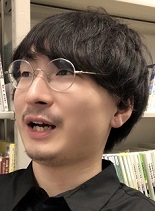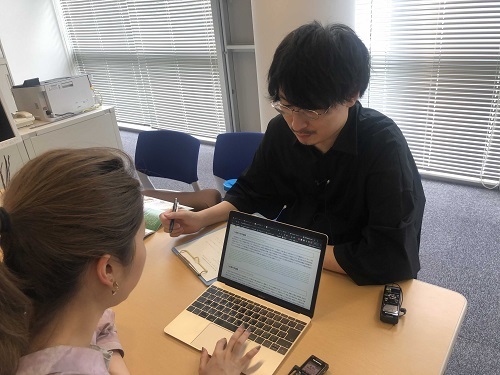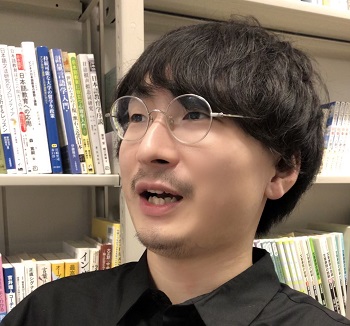Interview with Liberal Arts Communicator IWASAKI Takuya

The National Institutes for the Humanities (NIHU) are engaged in research on human culture from diverse perspectives toward better understanding of coexistence among people and harmony between nature and humanity. In order to deepen research in the humanities it is critical to facilitate communication between researchers and society.
As part of this effort to enhance such communication, NIHU holds various events for the general public and also provides training programs for liberal arts communicators who facilitate and engage in “two-way communication” between experts and non-experts.
Who are these “liberal arts communicators?” What kinds of activities do they engage in? This series of articles provides answers to those questions.
This edition features Dr. IWASAKI Takuya, who took up the new position of liberal arts communicator at NIHU’s National Institute for Japanese Language and Linguistics from July 2020.
You specialize in Japanese linguistics. Please tell us about your research theme.
I study the Japanese writing system and my master’s thesis and doctoral dissertation explored Japanese punctuation marks. The Japanese language has no official rules for how to punctuate text, and things are especially vague for commas (tōten). This is why even the way native Japanese speakers insert commas is said to vary from person to person. To better understand why, I have been aggregating findings about when people use tōten, based on data collected from a massive compilation of texts containing tōten written by native Japanese speakers. (See IWASAKI Takuya, “Tōten ga setsuzokushi no chokugo ni utareru yōin: Elastic Net o shiyō shita moderu kōchiku to hyōka” [Factors Involved in Placing Comma Immediately Following a Conjunction: Modeling and Evaluation by Using Elastic Net],” Keiryō kokugogaku [Mathematical Linguistics] 31:6 (2018), 426–442.)
Another area of my research involves how people studying Japanese as a second language use tōten. I look into differences between them and native Japanese speakers in the way of inserting commas, as well as the degree to which one’s mother tongue affects comma usage. (“Nihongo gakushūsha no sakubun kōpasu kara mita tōten to joshi no kankeisei” [An Analysis of the Relationship between Particles and Punctuation marks As Seen in the Usage of the Written Corpus by Japanese Language Learners], Hitotsubashi Daigaku Kokusai Kyōiku Sentā kiyō [Hitotsubashi University Journal of Global Education] 8 (2017), 27–39.)
Lately I have also been using big data to analyze how native Japanese speakers use parentheses in different contexts. (“Dai-5 shō: Kigō no shiyō jittai to sono mondaiten—Hatchūsha to juchūsha o tsunagu tame no kakko no katsuyō [Chapter 5: The Usage of Japanese Typographic Symbols and Associated Issues—Use of Parentheses to Connect the Sender and Receiver].” In Bijinesu bunsho no ōyō gengogakuteki kenkyū: Kuraudo sōshingu o mochiita bijinesu Nihongo no takakuteki bunseki [Linguistic Approaches to Analyzing Business Japanese Using Crowdsourcing], edited by Kei Ishiguro. Tokyo: Hitsuzi Shobō, 2020.) It is very interesting how personal preference influences the way people use parentheses and commas, as these are areas that not even native Japanese speakers are taught in school or do not remember from their lessons (laughs).
Currently I am especially focusing on the way the Japanese writing system is used when intended for foreign permanent residents in Japan, such as the addition of spaces between words (wakachi-gaki) or ruby pronunciation aids. These tend to be inserted from a native speaker’s standpoint, so I hope to examine how to make them more legible and readable for non-native speakers.

IWASAKI conducting an interview on text readability
What inspired you to become a liberal arts communicator?
One of the aspects that appealed to me is that liberal arts communicators can serve as a bridge connecting society to both the lore of previous research and access to what will be studied in the future.
Increase of telecommuting has highlighted the importance of not only video communication but also written communication. In text-based interaction, the key is to write clearly to avoid misunderstandings and structure texts in a way that is easy to both read and understand. I wanted to contribute to building a better society by communicating and sharing with the general public the results of my study on the Japanese writing system, such as approaches to using punctuation marks and parentheses.
I am also looking forward to refining my studies and delving deeper into my research, as I realized that the way people punctuate in Japanese varies and that I need to collect various viewpoints. I decided to aim for the liberal arts communicator position because I wanted to explore activities (such as studying, researching, and communicating) that can unite research and society, utilizing my expertise, and through my quest to render the texts we use in everyday contexts more understandable and readable.
The novel coronavirus pandemic was already raging when you were assigned to this post.
Please tell us about the activities you have done so far.
Since I started to work from home immediately after assuming the position, I have been unable to get engaged in the usual activities related to this post. But there are some that I can share with you.
One example is a video recording made from a joint lecture given by communicators including myself between Tsukuba University, National Museum of Nature and Science and NIHU institutions. The original plan was to go to the university and hold face-to-face conversations, but we decided to pre-record discussions made among liberal arts communicators, have Tsukuba University students view the videos as a pre-class assignment, and then hold discussion online. This proved to be a trial-and-error process, as we had never done anything like it before. But help from Tsukuba University’s professors and the talented and enthusiastic students enabled us to have quite in-depth discussion.
Another example would be the monthly study meetings for which liberal arts communicators gather. This serves as an opportunity to think about liberal arts communication through frequent online meetings and exchange of views and information with the other communicators who are based at institutions scattered across the Kansai or Kanto region.
Yet another undertaking is an online article series that liberal arts communicators have launched, called “Kurashi ni jinbunchi: Korona jidai o ikinuku (The Humanities in Everyday Life: Surviving the Novel Coronavirus Pandemic Era).” For this series, I contributed an article titled “Zaitaku kinmu no naka de no deai—Neko, Neko, Neko [猫・ねこ・ネコ]” (Chance Encounter While Working from Home—Cat, Cat, CAT). It is mainly about the encounter with the cat that is now my pet while I was adapting to telecommuting and changing my lifestyle. But I briefly analyze the various ways the word neko is written as well—I’m a specialist on the Japanese writing system after all (laughs).

IWASAKI’s new family member
How do you intend to advance your studies and engage in the activities of liberal arts communicators?
As I mentioned earlier, for my own research I hope to reveal through survey and research, and communicate to society how we can make the Japanese writing system used for the attention of permanent residents more readable and understandable. I also want to share with native Japanese speakers how they can use the writing system to better deliver the writer’s intent to readers in text-based communication formats such as business documents. In addition, I wish to explore is how to approach Japanese learners both in and outside Japan, since we should keep in mind that people who use this language are not limited to Japanese nationals.
As a liberal arts communicator at the National Institute for Japanese Language and Linguistics, and by exploring and sharing how the Japanese writing system can be presented in readily understandable ways, I hope to get the message across to people that research in the humanities is necessary for society.
(Interviewer: HOTTA Ayumi)

IWASAKI Takuya Liberal arts communicator, National Institutes for the Humanities Center for Information and Public Relations; Project assistant professor, National Institute for Japanese Language and Linguistics IWASAKI received his Ph.D. in philosophy from the Language and Society Major of the Graduate School of Language and Society, Hitotsubashi University in 2020. He took up his present position as Project Assistant Professor in the same year. IWASAKIs research interests center on aspects of the Japanese writing system such as punctuation marks.
